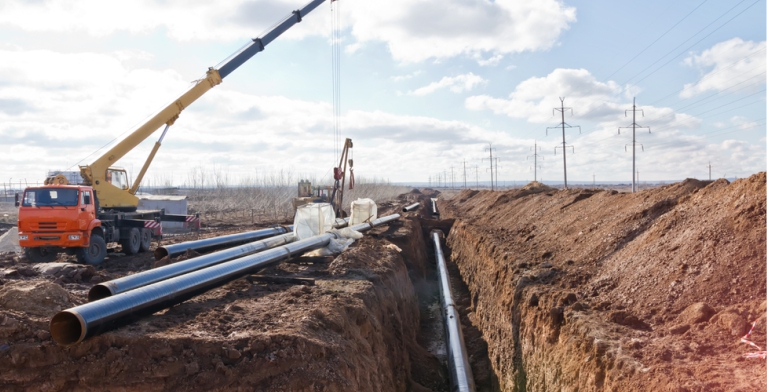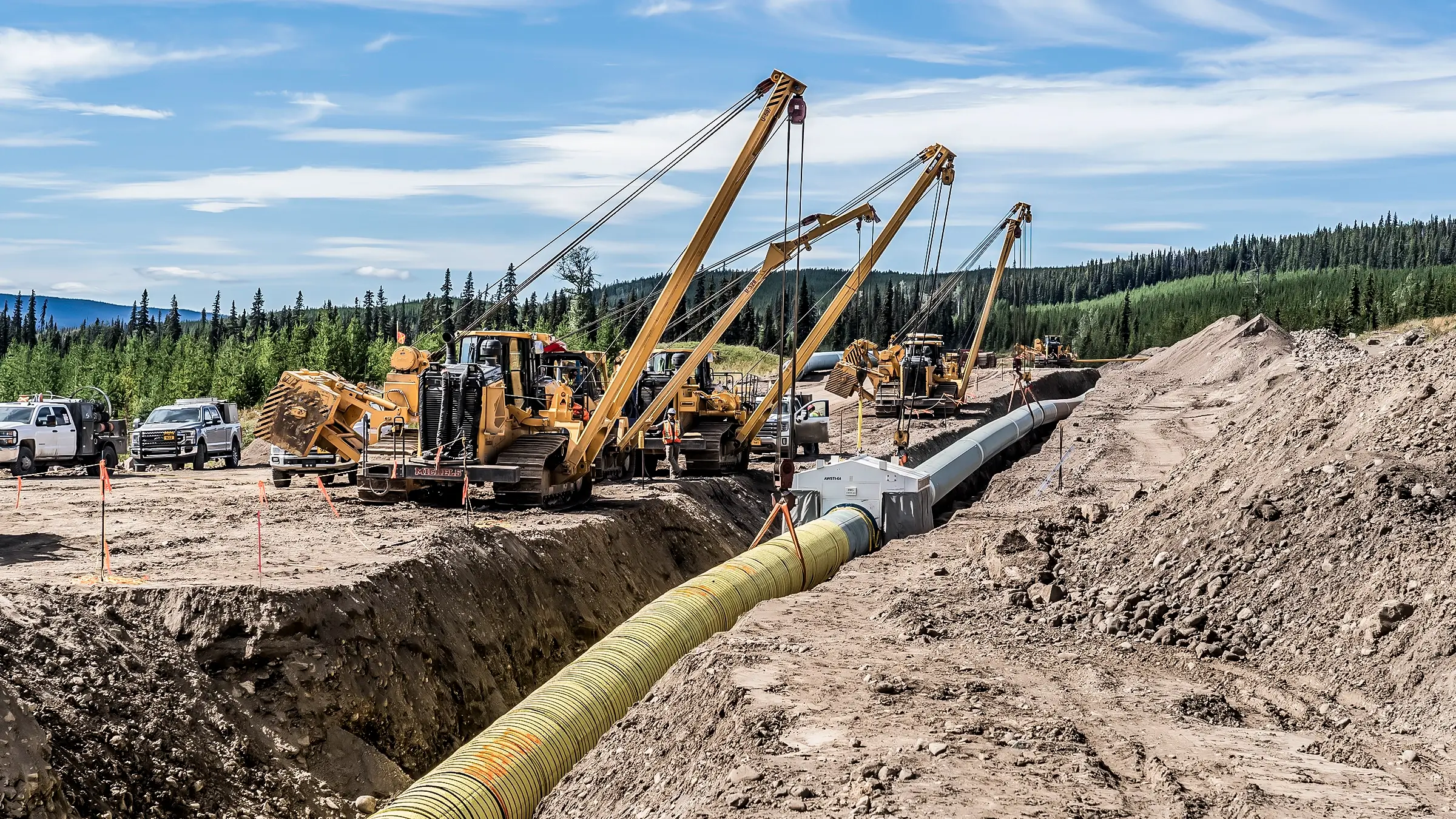Designing a Pipeline System? Here's Why Creek Pipe Texas oilfield Is Your Best Resource
The Significance of Pipeline Construction: Checking Out the Solutions Used in the Industry
Pipeline construction is an important part of modern-day infrastructure. It promotes the transportation of necessary resources like oil, gas, and water. The market incorporates various solutions, consisting of preparation, site prep work, and installation. Each phase requires accuracy and adherence to safety and security requirements. As areas rely on these systems for their resources, understanding the intricacies of pipeline construction exposes its significance and possible obstacles. What variables affect the success of these projects?
Review of Pipeline Construction Providers
Pipeline construction services incorporate a range of specialized tasks designed to promote the installment of pipes for moving various compounds, consisting of oil, gas, and water. These services typically consist of site prep work, excavation, installation of pipeline sectors, and backfilling. Proficient labor and sophisticated tools are essential for assuring each stage is executed with precision and safety.Safety methods are extremely important, as these jobs frequently entail dealing with dangerous materials and in challenging atmospheres. Quality control steps establish that the pipes meet industry standards and guidelines. In addition, the services may entail trenchless innovation, which lessens surface disruption.Environmental considerations play a considerable duty in pipe construction, requiring analyses and reductions to safeguard surrounding ecological communities. Overall, pipe construction services are vital for developing the framework necessary for energy and water circulation, supporting both financial development and societal requirements.
Planning and Layout in Pipeline Projects
Reliable planning and layout are vital parts of successful pipe tasks, making certain that all facets are carefully attended to before construction starts. This phase includes comprehensive usefulness studies that analyze the technical, economic, and ecological variables influencing the job. Designers and developers collaborate to develop comprehensive plans that lay out the pipeline path, materials, and construction techniques, aligning with regulatory demands and industry standards.Advanced software and modeling methods are typically employed to imitate different circumstances, maximizing the design for effectiveness and safety. Ecological impact evaluations are performed to mitigate prospective injury to ecological communities and communities, mirroring a commitment to sustainable techniques. Furthermore, stakeholder involvement is vital, fostering interaction and dealing with problems from impacted parties. Ultimately, effective planning and style established the foundation for a pipeline project, minimizing dangers and ensuring a streamlined construction process, eventually adding to the general success of the procedure.
Site Preparation and Excavation
Thorough site prep work and excavation are necessary action in the pipe construction procedure. This stage involves a thorough analysis of the land where the pipe will certainly be installed. Project groups perform surveys to determine soil types, topography, and existing utility lines to guarantee a safe and efficient excavation. Proper site preparation reduces environmental impact and helps with smoother construction operations.Excavation complies with, where heavy machinery is employed to get rid of soil and rock, creating a trench that meets the defined deepness and width for the pipeline. This procedure has to stick to security policies and environmental standards to protect against damages to surrounding ecosystems.Additionally, erosion control measures are implemented to stabilize the website throughout and after excavation. Efficient website preparation and excavation contribute substantially to the general success of pipeline projects, laying a solid foundation for the subsequent phases of construction.
Pipeline Installation Techniques
Pipeline installation techniques are crucial for the effective implementation of infrastructure tasks. 2 popular techniques include trenchless technology, which reduces surface disruption, and the open-cut excavation process, understood for its uncomplicated technique. Each technique uses unique benefits and factors to consider relying on job needs and ecological factors.
Trenchless Innovation Methods
While standard methods of pipeline installment usually involve considerable excavation, trenchless technology approaches provide a more reliable and eco-friendly alternative. These cutting-edge methods, such as straight directional drilling and pipeline bursting, decrease surface interruption by enabling the installation of pipelines without considerable digging. This not only minimizes the ecological impact but likewise considerably cuts down on labor and repair prices. Trenchless methods promote the installment of pipes in metropolitan areas where standard excavation would be unwise or damaging to existing facilities. In addition, these techniques can fit different soil kinds and conditions, making them versatile options for pipe construction. Inevitably, trenchless innovation stands for a considerable advancement in the pipe industry, promoting sustainability and operational effectiveness.

Open-Cut Excavation Process
Open-cut excavation remains a fundamental technique in pipe installment, identified by the straight excavation of a trench to lay pipelines. This technique includes eliminating soil and other materials to develop a trench of enough deepness and size, permitting the placement of pipes at the required quality. Open-cut excavation is usually favored for its cost-effectiveness and simpleness, particularly in areas with secure dirt problems. However, it can disrupt surface area tasks and needs careful planning to take care of website traffic and environmental impacts. Safety and security measures need to be carried out to safeguard workers and neighboring facilities during the excavation procedure. In general, while open-cut excavation might not appropriate for all terrains, it continues to be a commonly used technique in pipeline construction.
Examining and High Quality Assurance
Checking and quality guarantee are essential elements in pipe construction, making sure that installations fulfill well established safety criteria and performance needs. Various examination methods and methods are used to examine material top quality and adherence to regulative conformity. This methodical method assists identify prospective issues before they rise, securing the stability of the pipeline system.

Evaluation Techniques and Methods
Examination strategies and approaches are crucial elements in guaranteeing the integrity and safety and security of pipe construction. Different approaches, consisting of aesthetic assessments, ultrasonic testing, and radiographic evaluations, are employed to find problems and validate high quality. Aesthetic inspections permit the identification of surface abnormalities, while ultrasonic screening uses audio waves to evaluate wall surface density and situate problems inside. Radiographic examinations include X-rays or gamma rays to generate images of the pipeline's structure, exposing surprise issues. Furthermore, pressure screening is conducted to assess the pipe's honesty under functional conditions. These techniques jointly contribute to a detailed understanding of the pipe's problem, making read the full info here it possible for prompt upkeep decisions and making sure conformity with market criteria. Reliable inspection is crucial for stopping failings and promoting long-lasting operational security.
Security Criteria Compliance
Guaranteeing compliance with safety standards is paramount in pipeline construction, as it straight influences the task's total top quality and dependability. Sticking to well established guidelines and standards assurances that construction practices mitigate threats connected with pipe installment and operation. Creek Pipe near me. Extensive testing methods, consisting of non-destructive testing and stress evaluations, are important in verifying that pipelines can withstand the functional anxieties they will encounter. Quality control actions are likewise vital, as they establish a structure for constant monitoring and analysis throughout the construction procedure. By prioritizing safety criteria conformity, companies not just secure workers and the setting however also boost the stability of the pipeline, ultimately leading to lasting operational success and public rely on the infrastructure
Material Quality Examination
Material quality analysis plays a considerable function in the overall honesty of pipeline construction. This procedure involves rigorous screening and quality control actions to guarantee that products fulfill industry requirements and requirements. Various tests, consisting of tensile toughness, corrosion resistance, and weld stability analyses, are conducted to identify any type of possible weak points. An extensive analysis not only guarantees the performance of the pipe yet also improves safety and security and toughness over its lifespan. Additionally, implementing top quality control procedures assists alleviate dangers associated with product failings, which can cause expensive repair services and ecological threats. By prioritizing material quality assessment, business can ensure compliance with regulative demands while promoting confidence among stakeholders in the dependability of their pipeline systems.
Maintenance and Repair Work Solutions
Repair and maintenance services play a vital function in the durability and effectiveness of pipeline systems. These services encompass regular inspections, repairing, and rehabilitative activities to attend to damage, leakages, and other issues that may arise over time. Experienced technicians utilize innovative modern technologies such as ultrasonic screening and wise pigging to check pipe stability, making sure that any kind of prospective problems are recognized early.Additionally, maintenance programs frequently include scheduled preventative procedures developed to improve system reliability and minimize the probability of unexpected failings. Repair services might include the replacement of broken sections, sealing leakages, or employing trenchless modern technology for minimal interruption.
Environmental Compliance and Safety And Security Steps
Pipeline systems not just need recurring repair and maintenance to operate efficiently yet also have to follow rigorous environmental conformity and precaution. These guidelines are important for decreasing environmental influence and guaranteeing public safety and security. Companies in the pipeline construction sector implement detailed environmental assessments before project initiation, recognizing prospective threats to wildlife and ecosystems.Furthermore, adherence to security methods protects workers and bordering areas. This includes routine training on emergency situation feedback and spill prevention techniques.To preserve conformity, sectors utilize keeping an eye on modern technologies to spot leakages and various other abnormalities in navigate to this site real-time. Environmental administration strategies are often developed to detail actions for addressing unexpected problems during construction.Ultimately, stringent adherence to ecological conformity and safety and security measures not only fulfills legal obligations however additionally cultivates sustainable practices within the industry, promoting an equilibrium in between infrastructure advancement and ecological stewardship.
Often Asked Concerns
What Career Opportunities Are Readily Available in Pipeline Construction?
Career opportunities in pipeline construction incorporate roles such as project supervisors, designers, welders, and safety inspectors. These settings call for varied abilities, offering paths for development in a vital market of framework development and energy distribution.

Just How Do Pipeline Projects Influence Citizen Communities?
Pipeline projects considerably influence local areas by affecting economic growth, providing job opportunities, and enhancing infrastructure. Nevertheless, they may additionally increase concerns concerning environmental results, land usage, and potential disturbances to neighborhood cohesion and all-natural ecological communities.
What Modern technology Is Utilized in Modern Pipeline Construction?
Modern pipeline construction makes use of sophisticated innovations such as GIS for mapping, drones for aerial studies, and automated welding systems to boost performance, security, and precision, eventually assisting in the effective transport of resources across various surfaces. Creek Pipe Midland.
How Are Pipeline Construction Expenses Estimated?
Pipeline construction expenses are approximated via comprehensive evaluations of products, labor, tools, and regulatory demands. Aspects like surface, more information project size, and environmental factors to consider additionally significantly influence the general spending plan and economic preparation for construction.
What Are the Most Significant Difficulties in Pipeline Construction Projects?
The greatest obstacles in pipeline construction projects include regulative compliance, ecological problems, logistical concerns, securing funding, and handling labor lacks. Each aspect can greatly impact timelines and budget plans, making complex the total implementation of the project.